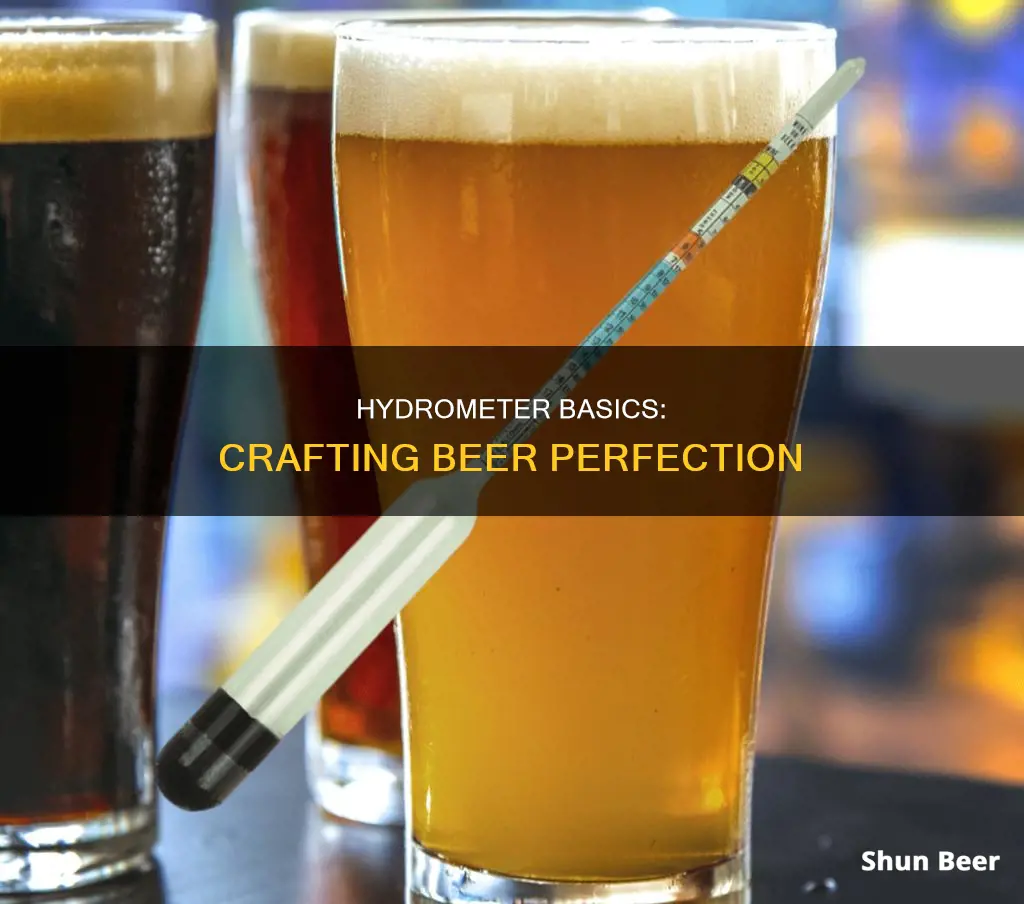
A hydrometer is a simple device that measures the density of a liquid by comparing it to water. It is an essential tool for brewing beer as it shows how yeast is converting sugar into ethanol, which in turn indicates the health and success of the fermentation process. The hydrometer measures the amount of sugar dissolved in water, referred to as Specific Gravity (SG). This sugar is what the yeast turns into alcohol during fermentation. By measuring the Original Gravity (OG) of the wort before fermentation, brewers can estimate the amount of alcohol that can be produced. After fermentation, the Final Gravity (FG) is measured, and the alcohol content can be calculated.
| Characteristics | Values |
|---|---|
| Purpose | Measure the ratio of a sample liquid’s density to the density of water |
| Use | Show the degree to which yeast is converting sugar into ethanol |
| Function | Alert users of issues during fermentation |
| Process | Retrieve a sample, insert the hydrometer, obtain the original gravity reading, calculate with temperature, obtain the final gravity reading |
| ABV Calculation | (OG - FG) / 7.362 = ABV |
| Specific Gravity | Measure the amount of sugar in the liquid |
| Sugar Conversion | As more sugar is converted to alcohol, the gravity will fall |
| Calibration | Most hydrometers are calibrated to read at 20°C (68°F) |
What You'll Learn

How to read a hydrometer
A hydrometer is a device that measures the density of a liquid compared to water. It is used in brewing to determine the amount of alcohol in a beer. Here is a step-by-step guide on how to read a hydrometer:
Step 1: Sanitize
Sanitize the hydrometer and the container for the liquid sample. This ensures that your equipment is clean and free of any debris that could affect your reading.
Step 2: Fill
Pour your liquid sample into a tall, narrow container, such as a test jar. Fill it with enough liquid to allow the hydrometer to float freely without touching the sides or bottom.
Step 3: Float
Gently lower the hydrometer into the sample and give it a spin to release any air bubbles. This ensures that your hydrometer is properly suspended in the liquid and provides an accurate reading.
Step 4: Read
Once the hydrometer settles, read the scale at the liquid's surface, also known as the specific gravity. This reading will give you insights into the density and potential alcohol content of your brew. Make sure to read the hydrometer at eye level for the most accurate results.
Understanding Readings:
The specific gravity readings will vary depending on what you are brewing. For example, a typical beer's original gravity (OG) is between 1.035 and 1.060, while a wine's OG is usually higher due to its higher sugar content. After fermentation, you will take another reading called the final gravity (FG). The difference between the OG and FG will indicate how much sugar has been converted into alcohol.
Troubleshooting:
There are a few common issues to look out for when using a hydrometer. Air bubbles can cling to the hydrometer and affect your reading, so gently spin the hydrometer to release them. Temperature can also impact your readings, as hydrometers are calibrated for a specific temperature (usually around 60°F or 15°C). Use temperature correction charts or calculators to adjust your readings accordingly.
Beer as Petrol: Can You Really Run on Hops?
You may want to see also

When to use a hydrometer
A hydrometer is a crucial tool for brewing beer at home. It allows you to determine the original and final gravity of your brew, and, in turn, calculate the alcohol content. Here's when to use a hydrometer during the beer-making process:
Before Pitching the Yeast:
Take your first measurement, known as the original gravity (OG), after the cool-down process but before pitching the yeast. This reading indicates the original sugar density in your wort. To obtain this reading, sanitise your equipment, then use a beer thief to draw a sample of the wort and transfer it to a testing jar or cylinder. Place the hydrometer in the sample and let it float freely. Once all the air has escaped, centre the hydrometer vertically to get an accurate reading.
During Fermentation:
The fermentation process is where the hydrometer really comes into its own. It allows you to monitor how the fermentation is progressing and alerts you to any issues, allowing you to make adjustments. Take readings during active fermentation to gauge how much sugar is being converted into alcohol. Remember to sanitise any equipment that comes into contact with your wort/beer, and be cautious of CO2 bubbles adhering to the hydrometer, which can affect the reading.
End of Fermentation:
Take another hydrometer reading when the fermentation process is complete or nearing its end. This reading is called the final gravity (FG). By comparing the OG and FG, you can estimate your beer's alcohol content using a simple formula: Final Gravity - Original Gravity x 131.25 = ABV.
Troubleshooting:
If you encounter any issues during fermentation, such as stuck fermentation, you may need to take additional readings. However, exercise caution as each test increases the risk of exposing your beer to harmful air or bacteria.
Remember, the hydrometer is a delicate tool that provides insight into the fermentation process. By taking readings at the right times, you can ensure a successful fermentation and, ultimately, a delicious beer.
BeerSmith Compatibility: Apple Devices and Beyond
You may want to see also

How to calculate ABV
A hydrometer is a tool used to measure the density of a liquid. It is an essential piece of equipment for making wine and beer. It works by measuring the specific gravity (SG) of a liquid—essentially, the ratio of the liquid's density to that of water.
The SG of a liquid tells you how much sugar is in it. As the yeast in a brew turns sugar into alcohol, the SG will decrease. This is how a hydrometer can be used to calculate the ABV (alcohol by volume) of a brew.
To calculate ABV, you need to take two readings with a hydrometer: the original gravity (OG) and the final gravity (FG). The OG is the density of the liquid before fermentation, and the FG is the density of the liquid after fermentation.
- Sanitize your hydrometer, a trial jar (to collect a sample of your brew), and a sampler (to draw the sample).
- Fill the trial jar about halfway with your brew.
- Place the hydrometer in the trial jar. It will sink to a certain depth, depending on the density of the liquid.
- Spin the hydrometer gently to release any bubbles on its surface and to ensure it is not sticking to the side of the jar.
- Take the OG reading from the bottom of the meniscus (the curved surface of the liquid).
- Let the fermentation process occur.
- When fermentation is nearing completion, take another sample of your brew and repeat steps 2-5 to obtain the FG reading.
- Calculate the ABV using the following formula: (OG – FG) x 131.25 = ABV.
It is important to note that the temperature of the liquid can affect the accuracy of the hydrometer reading. Most hydrometers are calibrated to read at 15°C or 20°C, so you may need to adjust your readings if the temperature of your brew is different. Online calculators can help with this temperature correction.
Bottom-Fill Beer Cups: How Do They Work?
You may want to see also

How to calibrate a hydrometer
A hydrometer is a device that measures the density of a liquid compared to water. It is commonly used to brew beer or ferment wine. To brew beer at home, you will need to use a hydrometer.
To calibrate a hydrometer, follow these steps:
- Identify the parts of the hydrometer. A hydrometer is a glass device with a bulbous, weighted end designed to float in a liquid, and a narrow, long stem with a graduated scale on the other end.
- Fill the test jar with the water you will be using for brewing. Most hydrometers come with a test jar for measuring and taking readings.
- Keep the test jar the same temperature as the brewing liquid. Store the test jar with water next to your brewing station.
- Take a reading of the reference sample (water). Spin the hydrometer in the water to get rid of any bubbles that might affect the reading and ensure the hydrometer isn't touching the sides of the test jar.
- Take a reading of the brew sample. After recording the reference sample reading, clean the hydrometer and take a reading of your brew sample.
- Adjust your brew reading according to the reference sample. Ideally, the water reference sample will read 1.000. If this is the case, you do not need to do any calculations with your brew sample.
It is important to note that most hydrometers are calibrated to a reference temperature of 60°F (20°C). When purchasing a hydrometer, the manual should state the temperature at which the hydrometer can be used. For best results, take readings of your liquid at this reference temperature.
Antibiotics and Beer: A Safe Mix?
You may want to see also

How to adjust for temperature
When using a hydrometer to make beer, it is important to adjust for the temperature of the sample. This is because hydrometers are calibrated to work at a certain temperature, and readings taken outside of that range can be inaccurate. Most hydrometers are calibrated for a temperature of either 60°F (16°C) or 68°F (20°C). The calibration temperature is usually printed on the scale of the hydrometer, so it is important to check this when using your hydrometer.
If you are measuring a sample that is not at the calibration temperature, you will need to adjust the reading to compensate for the temperature difference. This is particularly important when measuring hot wort, such as that from the mash, pre-boil, or post-boil. It is also important when fermenting lagers.
To adjust for temperature, you can use a temperature correction chart or an online calculator. These tools will help you calculate the difference between the calibration temperature and the sample temperature, and determine the correct specific gravity.
- Check the calibration temperature of your hydrometer. This information should be printed on the scale of the hydrometer.
- Measure the temperature of your wort or beer sample.
- Calculate the temperature difference between the calibration temperature and the sample temperature.
- Use a temperature correction chart or an online calculator to determine the correct specific gravity based on the temperature difference.
- Adjust your hydrometer reading accordingly to get an accurate measurement.
By following these steps, you can ensure that your hydrometer readings are accurate and that your beer-making process is on track.
Beer Fast: Does It Work Quickly?
You may want to see also







